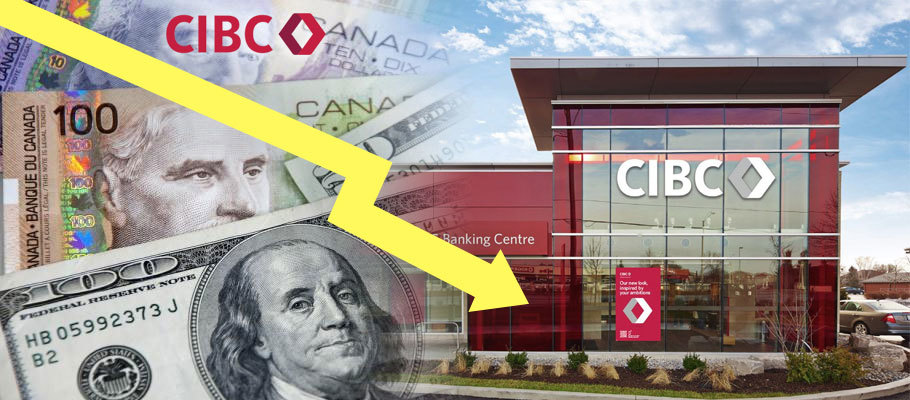
Published: October 5th, 2021
Canadian lender CIBC’s forex analysis unit says there are signals that the loonie, a solid performer throughout 2021, will face rising challenges in the coming months. If true, it means the majority of CAD’s 2021 gains may now be finished.
In its monthly exchange rate forecast, CIBC said that Canada’s central bank, the Bank of Canada (BoC), will need to dial down its efforts to tighten up monetary policy, thereby robbing CAD of a crucial vector of support.
‘Canada’s central bank will need to go forward more cautiously as it manages the current 2023 tightening cycle. High levels of household debt could impact economic growth if an interest rate increase triggers a reduction in consumer spending.’
The warning comes after months of outperformance for the loonie. It’s ascended against all its G10 peers, lifted by a robust economic rebound and the BoC’s decision to start paring back it's quantitative easing (QE) programme after a series of positive growth signals.
The Canadian dollar's 2021 gain against the greenback, however, has deteriorated rapidly in recent days following a surge in USD safe-haven demand, driven by rising fears in some sectors that an emergent energy crisis and dormant supply chains not quite ready for a return to ‘normal’ could slow global economic growth.
US dollar gains are also being prodded by signals that the Federal Reserve is growing worried about inflation and likely moving towards shuttering its own quantitative easing programme before any rise to interest rates.
At the time of writing, the USD/CAD exchange rate was 1.2720. Against the pound, CAD extended its 2021 advance last week to 1.79 per cent, with the pound-to-Canadian dollar rate sitting at 1.7096.
CIBC found that while the Canadian dollar is categorised as a commodity currency thanks to the country’s reliance on oil and mineral exports, the looming global energy crisis may not have a severe impact on CAD valuations.
‘The loonie hasn’t had much traction in recent days, despite the uptick in prices of natural gas and crude oil. There’s a growing consensus instead for more pronounced tapering by the Federal Reserve, while subsequent rate hikes have dulled what would normally be commodity price enthusiasm for CAD’.
CIBC says the setbacks to oil supply from OPEC and hurricane Ida will likely prove temporary.
The driving force for CAD next year will be the extent to which markets raise assumptions about Fed tightening vis a vis what the Bank of Canada is signalling.
Analysts believe the Bank of Canada is set to disappoint markets while the Fed may prove to be more hawkish.
‘While the BoC is expected to taper its QE program further this month, the October policy meeting may push back the forecast timescale for achieving a zero output gap, possibly into the final months of 2022. If that occurs, expect markets to price in a lighter path for its policy rate’.
There is widespread anticipation that the US Fed will up the pace of tapering in November. CIBC believes this will prompt investors to raise their medium-term bets for the fed funds rate, potentially resulting in a weaker loonie next year.
It’s thought that the Bank of Canada will ease off its timeline for normalisation if a slowdown in Canada's economic recovery happens.
CIBC's analysts have revised their Canadian economic forecasts downward, saying the economy’s growth in the second quarter thanks to slowing home sales and supply chain issues. The factors distanced Canada’s economy from hitting a positive output gap after a broader slowdown in commercial activity and exports when the pandemic began.
The COVID-19 Delta wave took a toll on activity, something CIBC has taken into account. As it continues to spread in major centres like Toronto and Vancouver, delta is expected to have a more significant impact on Canadian output and raise the economy’s exposure to international demand and supply chain issues suffered by Canadian exporters.
Looking ahead, CIBC belies growth could be weighed down by Canada's high levels of household credit card and mortgage debt, plus a deterioration in Canada’s international balance of trade as its current account surplus moves back into deficit.
In late August, CAD suffered losses in the same week that economic indicators suggested the country's economy was in excellent health. Markets turned gloomy as risk-averse traders ignored strong retail sales data, which clearly indicated a robust, if still pending, recovery for Canada's economy.
Numbers from Statistics Canada (Statscan) measured second quarter Canadian retail sales up by a healthy four per cent. That was a touch below the 4.3 per cent expected by economist consensus. Core retail sales were by 4.5 per cent, however, which was a rise on the 4.4 per cent markets were expecting.
Statscan number crunchers don’t include sales of large items like cars or take gasoline sales at the fuel pump into account since their respective price tags and price volatility could distort the numbers.
The slight rise in retail sales came after several Canadian provinces allowed non-essential businesses to come out of lockdown, following a slowdown in the spread of delta-variant coronavirus infections.
Markets resisted the good news, however, perhaps signalling that expectations were already building for a CAD correction in Q4. The Canadian dollar fell lower after the data release, continuing what had been a week of ups & downs and placing it near the bottom of the G10 major currency pack.
In hindsight, analyst forecasts for recovery in global demand were already becoming less confident. CIBC told Bloomberg that the downbeat response to Canada’s positive retail numbers on August view could be down to the rise in Delta variant cases, but that it was also ‘becoming harder to ignore that CAD sentiment has soured across the board in recent weeks.’